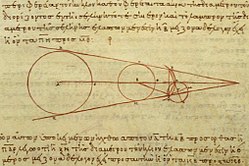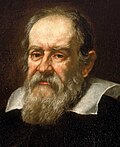Heliocentrism
Heliocentrism is the idea that the Earth and other planets revolve around the Sun, which is the center of the solar system.[1] Many people proposed heliocentrism, such as Aristarchus of Samos from ancient Greece,[2] but Nicolaus Copernicus was the first to think of good reasons why it is true. This was the beginning of modern astronomy.[3]
History
Before Copernicus, most people thought that the Sun and the other planets revolved around the Earth (this was called geocentrism). This is because if you stand on Earth, it looks like the Sun and stars are moving across the sky. However, when people watched for many years they saw many things that did not make sense if the Earth was the center of the Solar system. For example, sometimes the planets seemed to move back and forth instead of moving around the Earth. Copernicus explained why these things happen in 1543, when he published the book De revolutionibus orbium coelestium ("On the revolutions of the heavenly spheres"). This gave his reasons for thinking the Sun was at the center instead.
Other astronomers who made further advances after Copernicus were Johannes Kepler and Galileo Galilei. For example, Kepler showed that the planets do not orbit in perfect circles, and Galileo built very good telescopes that helped to confirm the heliocentric model.
Copernicus also thought that the sun was the center of the universe, but we now know that this is incorrect. The Sun is part of the Milky Way galaxy which is one out of billions of galaxies.
Further reading
- Dreyer, J.L.E. (1953), A History of Astronomy from Thales to Kepler, New York, NY: Dover Publications, ISBN 0-486-60079-3
- Linton, Christopher M. (2004), From Eudoxus to Einstein—A History of Mathematical Astronomy, Cambridge: Cambridge University Press, ISBN 978-0-521-82750-8
- On the Revolutions Archived 2012-04-15 at the Wayback Machine; translation of De Revolutionibus with commentary by Edward Rosen, Baltimore, Johns Hopkins University Press, 1992, ISBN 0-8018-4515-7.
Heliocentrism Media
Andreas Cellarius's illustration of the Copernican system, from the Harmonia Macrocosmica
Aristarchus' 3rd century BC calculations on the relative sizes of Earth, the Sun, and the Moon, from a 10th-century AD Greek copy
An illustration from al-Biruni's astronomical works explains the different phases of the Moon with respect to the position of the Sun.
Portrait of Nicolaus Copernicus (1578)[a]
In the 17th century AD, Galileo Galilei opposed the Roman Catholic Church by his strong support for heliocentrism.
A Philosopher Lecturing on the Orrery (1766) by Joseph Wright, in which a lamp represents the Sun
References
- ↑ The Shorter Oxford English Dictionary (6th ed., 2007)
- ↑ Dreyer (1953), pp.135–48); Linton (2004), pp.38–9).
- ↑ Barbara Bieńkowska 1973. The scientific world of Copernicus: on the occasion of the 500th anniversary of his birth, 1473–1973. Springer. ISBN 9027703531
Cite error: There are <ref> tags on this page, but the references will not show without a {{Reflist|group=lower-alpha}} template or a <references group="lower-alpha"/> tag.








